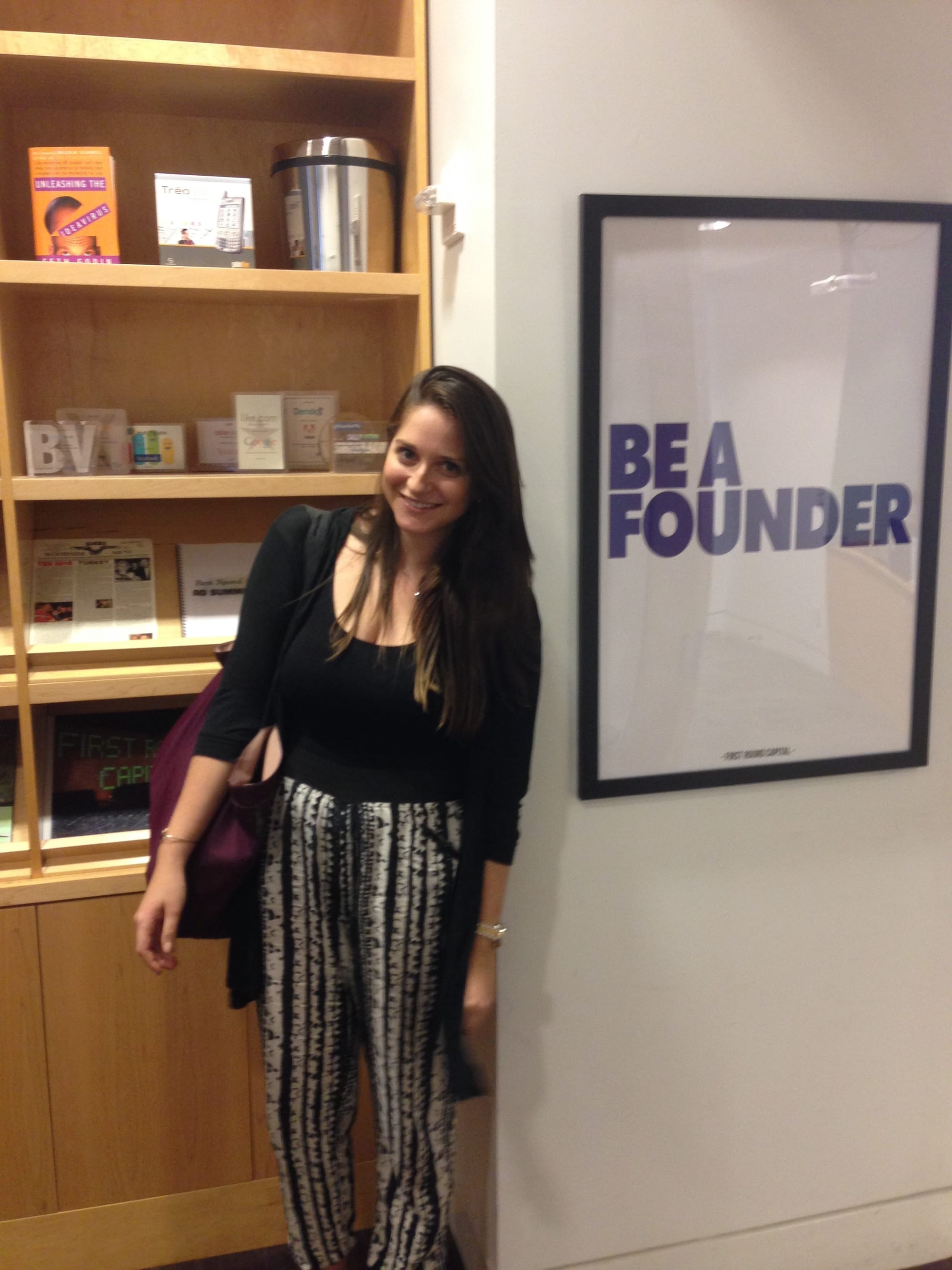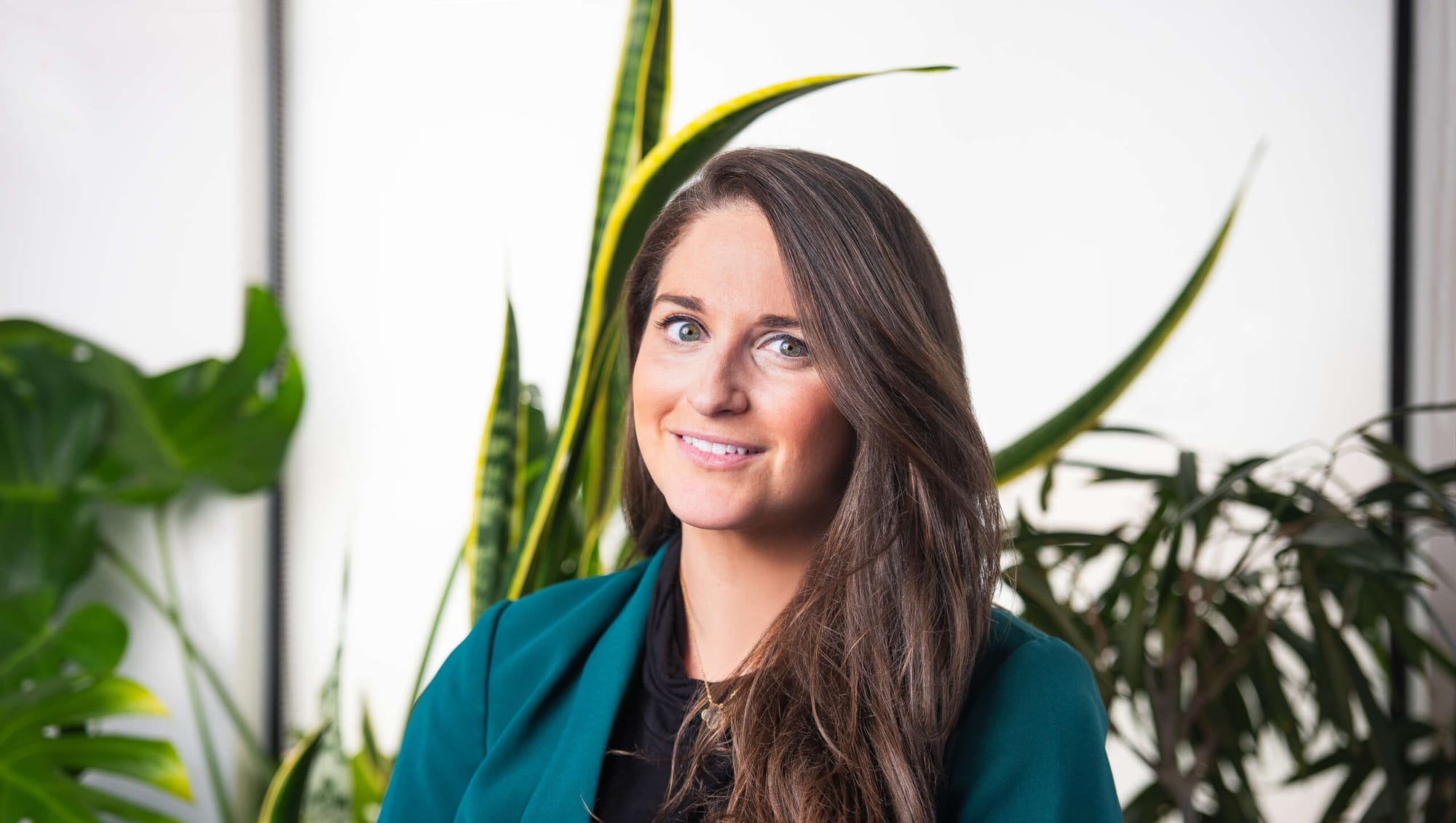This article is by Liz Wessel, a Partner here at First Round. In 2014, Wessel co-founded WayUp, which she ran for nearly 8 years. During that time, she raised over $40 million in venture funding from firms like General Catalyst and Index. She also angel invested in startups like Ramp, Scale AI, Ro, and Artera. After exiting WayUp, she joined Y Combinator as a Visiting Partner, where she worked with hundreds of companies, helping many of them prepare for fundraising pitches — including partner meetings for their seed rounds.
As a former founder, I still vividly remember my first partner meetings as we were raising our round coming out of Y Combinator. I remember having no clue what to expect going in, and googling as much as I could to understand how best to prepare as a founder whose startup had existed for less than a year. And yet, while I knew that the fundraising process is far from transparent, I was surprised by how little advice existed for seed stage companies on how to navigate partner meetings.
Nine years later, I joined First Round. And now, as I bring companies into our partner meetings, I often get calls the night before to ask: What should they expect? How can they best prepare? After answering these questions several times over, it dawned on me that it might be valuable to document my answers and share them more widely. So, after developing a 360-degree view of the VC partner meeting dynamic, I’m pulling back the curtain on one of the most significant (yet mysterious) parts of the fundraising process.
Pitching your company is more art than science, but my hope is this article gives first-time founders the tools they need to feel more confident and prepared before stepping into a partner meeting, no matter the firm. And, in the spirit of the First Round Review, I’ve also asked a handful of founders who were, up until very recently, in the same boat as first-time pitchers, to share their own advice.
Just an important note: not all firms require a partner meeting. From my experience, I find that a large percentage of the top tier institutional firms do have partner meetings even at the seed stage (First Round included), but if a firm you’re speaking with doesn’t mention an Investment Committee (IC) or Partner Meeting (PM), it may not be a bad sign. They may just not require it.
With that, let’s dive in.
1. Setting the scene: How a partner meeting differs from a 1:1 investor pitch
Like many founders, before I ever attended my first partner meeting, my fundraising journey started with 1:1 pitches. It was 2015, and l was about to finish an intense few months as a founder in Y Combinator’s winter batch. My co-founder JJ and I had started to see early traction with WayUp (then called Campus Job), our marketplace platform that connected employers to college students. So we set out to secure our first term sheet from an institutional fund.
I had been warned that many VCs were unintelligent, greedy, transactional, or just mean — so I prepared for harsh conversations with plenty of gotcha questions. But I was pleasantly surprised to find that was not the case at all. Most partners I met with were curious and friendly, from our first 1:1 meeting through to the partner meeting.

Still, knowing exactly what to expect can help ease the nerves. So how does it work? With most Silicon Valley institutional firms investing at the seed stage, startups typically have two to three meetings that, from first meeting to final decision, can take anywhere from one to two days to three to four weeks. The first meeting is usually with your “point partner” (or sometimes, an associate or principal). If you’re meeting a partner, that partner is “point” because either they sourced the deal, or they’re the most relevant in the category (many partners have specializations, like “consumer” or “hardware,” and so on). Sometimes you'll have a second or third meeting with the same partner or a subset of partners, where they dig in more. Then the final stage is typically a partner meeting.
Here are some of the ways that a partner meeting differs from those earlier 1:1 investor meetings:
- Length of meeting: A partner meeting usually lasts 60 minutes. Compare that to a 1:1 meeting, which is typically 30-45 minutes.
- Attendees: While a first meeting will likely only be with one partner, there could be anywhere between 5-15 investors at the partner meeting, depending on the size of the firm.
- How investors prepare: While it’d be great if all partners show up to 1:1 meetings prepared and researched, that’s usually not the case. That being said, in a partner meeting setting, most partnerships have the point partner write an investment memo ahead of time, which the rest of the partners read.
- Introductions: Unlike on a 1:1 call where the investor introduces herself, in a partner meeting, there usually aren’t introductions on the VC side, as that would take up too much time from the pitch. Instead, if you want to learn about who is in the room, ask your point partner before the meeting or go to the firm’s website to learn more.
- Slides: Some founders believe they shouldn’t use slides for 1:1 pitches. However, for partner meetings, it is almost always recommended to come with slides, since it can help you guide the conversation and answer questions in more detail. It also just shows a stronger sense of preparation. I often recommend also having a large appendix of slides for your eyes only, that you can refer to if any of the partners ask for specific data that is easier to show visually. As a pre-seed company, you may not have a ton of detailed info yet, and that’s okay. But if you’re a company that has some users or customers, or you’ve been around for over a year, examples of appendix slides include: Cohort analysis (for B2C), competitive landscape chart, customer breakdown by revenue (for B2B), sales pipeline, and so on.
- Follow-up: After a 1:1 meeting, the next step is usually scheduling another meeting or some follow-up Q&A. However, after a partner meeting, expect things to move quickly. Usually, there’s a debrief meeting that happens that same day. Whether it’s right after your pitch or a little later in the day, partners will re-group to discuss their thoughts and then vote on whether or not to invest. Most firms will get a decision back to the founder within 24 hours of a PM — some firms (us included) try to get back to you within a few hours on that same day. Either way, you should expect a phone call from the partner, which is typically how they will let you know whether they’ve decided to move forward with an offer to invest.

2. Leverage your point partner
Now that I’m on the other side of the table at partner meetings, a key piece of advice I wish I knew when I was a founder is to lean on your point partner and treat them like they’re on your team.
Remember, the chances of a venture firm investing in your startup after an initial 1:1 meeting may be something like 5%, and the chances of getting to that first meeting are even lower. But your likelihood of getting an investment if you’ve already made it to the PM stage is much higher — after all, the point partner is taking up time from the entire partnership to bring you in, so they should have some conviction that this deal has a high enough chance of happening. (Firms often say their partner meeting “offer rate” is anywhere from 25-60%.)
When I was pitching as a first-time founder, I didn’t realize how “on your team” the point partner often is. After all, by bringing you in, they’re signaling to the whole partnership that they think you and your company are worth the time and effort of a meeting.
Yutong Sun is a first-time founder who had partner meetings in 2024 for the seed round of her company. During her fundraising process for Quantile Health, she spoke to her point partner a lot. When I asked her for her number one piece of advice for other first-time founders, here’s what she had to say: “When I was fundraising, I asked my point partner if I could spend 30 minutes with them on the phone a day before the partner meeting. I used this time to ask about what materials I should bring in, and for feedback on my pitch,” she says.“When they bring you in front of all of the partners, they're essentially vouching for you and the hard questions will likely come from the rest of the team.”

As you can imagine, even if they’re your champion, point partners still want you to stand on your own feet and see how you perform in a partner meeting setting without hand-holding. But when appropriate, you may get a nudge from them. The co-founder of Gumloop, Max Brodeur-Urbas (a company we invested in earlier in 2024) echoes the sentiment: "If you're in the partner meeting, someone in the room already believed in what you're building enough to put you there. Your job is to show the other partners what this person already sees,” he says. “There was more than one moment in the call where I forgot to highlight an interesting feature or factoid about the company and this investor intentionally brought it up. It feels like someone is already in your corner."
You should also lean on your point partner for feedback in advance of the partner meeting. Some questions to ask that could help you prepare better:
- 1. How much context will the others in the room have?
- 2. What parts of the pitch should I emphasize more, based on who is in the room?
- 3. How long should I spend on founder backgrounds vs the business’?
- 4. What parts should we do more work on ahead of the meeting?
- 5. What parts of the business will the partnership have the most questions or hesitations about?
Given how much time you’ll likely have spent with your point partner, you can also ask them for feedback after the partner meeting and after they debrief. If they invested: what were the things they were most excited about, and what were their concerns? If they didn’t invest, what held them back? You may not agree with the feedback, but you’re likely to get some real and honest feedback given how much time they’ll have spent on getting to know you and your business.
3. Try to build a picture of the role of the partner meeting at a firm
Unsurprisingly, power dynamics and decision-making models can sometimes play an important but often unspoken role in a venture capital firm. Savvy founders who can read between the lines and understand how this works in the context of a particular firm’s partner meeting will sometimes have a higher chance of walking out with a term sheet.
Of course, every firm and individual pitch is different, but generally speaking, there are three “archetypes” of how partner meeting fits into these decision-making models:
- The “rubber stamp:” This is a formality where a meeting might be needed, but if your point partner really wants to get the deal done, they can.
- The real decision-making arena: A space where partners are coming to their own conclusions in real time, based on you and your pitch. There will be a vote after you're finished presenting, where the partnership needs to either agree unanimously (rare), majority (common), or some version of that (points system, senior partner sign off, or something else). In these cases, how you perform in the meeting matters. More sink or swim, if you will.
- The way to double check a partner’s work, or officially veto: Another formality, but with a negative bent. This is likely more focused on seeing if any partner wants to veto the investment.
There’s likely not much of a change you should make to your pitch, but information is power, and doing a little bit of legwork to try to better understand these dynamics in advance may help you feel more in control and comfortable when delivering your pitch. One place to hunt for this information is by asking your point partner a few questions that try to get at how their firm makes decisions. Some questions I’d consider asking:
- What is the role of the partner meeting in your decision process?
- How does a decision actually get made after your partner meeting?
- What percentage of the companies that make it to partner meeting do you actually issue a term sheet for?
It also never hurts to ask a founder friend or colleague who has pitched the same partnership before, so you can hear about their unique experience when pitching the group:
- What was your experience pitching this group? What about in term sheet negotiations afterwards?
- What’s your best guess of the partner dynamic, given your experience?
- What made you go with (or pass on) their term sheet?
- Compared to other firms you pitched, what was unique about this firm’s partner meeting?
- Did anything surprise you about your experience in the partner meeting?
4. Prepare to get in the weeds
Since most firms don’t do too much (or any) diligence before taking a first 1:1 pitch with a founder seeking seed round funding, back when I was a founder, I assumed the same would be the case going into a partner meeting. However, at partner meetings, your ‘audience’ has often read through an investment memo and therefore will likely be more prepared to get into the weeds.
These documents can be anywhere from three to thirty pages, even at the seed round. Here are two examples from Bessemer: Auth0 (seed check) and Pinterest (Series A). Typical sections in an investment memo include:
- Founder backgrounds
- Market overview and problem
- Solution / Product
- Big vision
- GTM
- Traction
- Team
- Competitive landscape
- Deal dynamics
- Partner thoughts (what they like and don’t like)
- Founder diligence
- Market / Customer Diligence
Some firms write very quick one-pagers and do very little diligence, and others do much more extensive write-ups with several diligence calls.
At First Round, we typically have anywhere from 5-15 diligence conversations, all of which are with people who can speak about the business (such as prospective or actual customers) or who can speak about the founders (such as former colleagues). It may seem like that would take days or weeks, but diligence can often get consolidated into just 24 hours – especially if the founder provides customer references to the investor (assuming there are even customers to speak with – which there often aren’t).
Given the longer meeting time and the fact that many (or all) partners will have been briefed before the meeting, founders should prepare to answer very specific questions, perhaps prompted by learnings from diligence calls or competitive analysis (for example, partners may ask about specific concerns they heard from actual customers of yours). You also want to make sure you know your numbers extremely well, as they’ll have just spent time reviewing various data points about you (though knowing your numbers is key for all pitches, not just PMs). And on the flip side, if some partners have experience in your category (whether because they’ve invested in a relevant business or have taken pitches from your competitors), you should be prepared for more people in the room to potentially have a nuanced perspective on your business, or come into the room with a bias from the start.
When pitching Reducto, Adit Abraham ran into this firsthand. “We'd read each partner's bio before the meeting and realized that the collective partnership group had experiences or investments in nearly every vertical or type of company. Our guess was that questions in the partnership meeting would go much deeper than the average 1:1 meeting, and that the partners would have inside knowledge about any industry claims we made — and that turned out to be true,” he says.

Of course, you don’t want to assume that the partnership will be experts on your business or that they will have read anything in advance. So it’s important to start high-level and stick to your talk track. This is more just a warning to be prepared for anything!
5. Get ready to be interrupted
Most 1:1 meetings with investors should feel fluid, like you’re guiding the conversation, with questions coming along the way. But with a partner meeting, especially because partners have at this point likely read an investment memo about your company before attending the meeting, or because some partners may believe they’re “experts” in your space, they often have already identified some of the points they want to dig into.
As a result, you should be prepared to get all kinds of questions throughout your entire pitch, even if it’s unrelated to the slide you’re presenting. And take it as a good sign!
It’s not just the clip of questions, but the interruptions that I’ve seen throw founders off the most. So don’t let that happen to you.
One of my favorite tactics to prepare for this comes right from the pages of The Review, in a piece with former Pixar storyteller-turned-founder Oren Jacob. He details how he baked in interruptions to his practice sessions to model a realistic version of what would happen.
“Start your pitch and tell the person you are rehearsing with, by slide 2, they have to interrupt and ask a question that pertains to slide 12,” Jacob says. “Have them continue to pepper you with questions out of order so you can practice moving the conversation in and out of the various points that you want and need to make. It’s only by working the transitions in and out of your key points that you’ll actually get a real handle on the various bridges you can use to get to where you need to be in the conversation.”
Again, remember that being interrupted with questions is often a good sign, as it means the partners are engaged and interested.
6. Manage the clock
It happens more than you think. Whether it’s a well-rehearsed pitch or a founder coming in and winging it, make sure you utilize your time correctly so that you can cover all of your key points.
Time is already so precious in a partner meeting, so focus on the good stuff, like how many customer conversations you’ve had, or why you’re the perfect founder to build this. Between asking your partner for guidance ahead of time, and reading the room to stay flexible, try to avoid spending too much time on one section and losing interest from the group, or on the flip side, rushing through the details too fast.
My suggestion is to practice two versions of your slides with varying lengths: short and long. The former will help prepare you for a situation where you’re being interrupted non-stop, while the latter helps you in a situation where all you hear are crickets.
And if, for example, you have three key points you want to make in the meeting, try and keep track to ensure you’ve covered all three by the end.
One last thing that should go without saying, but don’t be late. It definitely is noticed when the entire partnership is waiting for several minutes on a founder. However, the same is true for investors. They should never be late and make you wait, either!

7. Look at the forest and the trees
People are often very good at high-level storytelling or explaining the atomic-level details, but rarely both. Founders tend to be more comfortable in one of those two spaces — better at telling you where they’re going than where they are, or better at diving into the weeds on what they’re doing today but not tomorrow.
The best pitches are ones that can altitude shift. The best founders can paint a picture of what they’ll be doing in 10 years and then zoom all the way down into the weeds of today and how they’ll get there.
It’s explaining act one, act two and act three, for example. They can move back and forth between those things and make them sound equally compelling.
This is particularly important for technical founders who are often used to explaining how their product works, bringing everything down to an atomic level. It’s a useful skill to have, but you likely want to cover a lot more than just that during a partner pitch meeting.
When Yutong from Quantile Health looked back at her seed pitches, she shared with us her favorite rehearsal technique for staying focused on the bigger picture: “Branch out to folks outside of your industry. My recommendation here is to always stick with your story, and practice beforehand with friends who have never heard you talk about your company before. The sweet spot for finding the right person to practice on is someone who gets your enthusiasm but only knows a little about the financial and technical details of your company. Think of a close friend who’s not involved in the business. This is also good prep for customer calls, later down the line. Your user could come from a completely different background to you, and your product might not be obvious to them either. So this works both ways.”
To go one layer deeper, she also shared this advice: “Then, ask friends to repeat it back to you. How close is their version to the truth you have about what the business has done? By hearing someone tell your own pitch back to you, you can pretty quickly figure out how much people are absorbing what you tell them, and where you need to tweak.”
If you’re still struggling because your product is super technical, or if you find you are getting the same questions from an investor again and again, I suggest getting proactive and practicing how you answer specific questions, as well as potentially sharing an FAQ doc with investors ahead of time. Not only will this ensure your point partner is getting the details of your business correct when he/she sends out the investment memo, but it can also be an efficient way to explain the more complex technology side of the business, freeing up more space for storytelling in the pitch.
Finally, when answering questions from investors, you want to make sure you can see both the forest and the trees. Oftentimes, investors will ask one thing, but the answer they are looking for is a layer deeper. This is called the “question behind the question” (or as my fellow First Round partner Meka Asonye calls it, the “QBQ.”) So founders should think about what the investor is really asking, and if they think they know what they’re getting it, they can even play it back. Consider addressing it by saying, “I think you are asking about this.”
8. Don’t forget to bring the energy
Partner meetings are a rare 45 to 60 minutes with the whole partnership of a firm who have likely been in back-to-back meetings all day. Despite this, I’m always surprised by how many founders, especially the experienced ones, show up with such low energy and speak in vague concepts. Of course, you also don’t want to overly course-correct and come off as inauthentic. (It rarely ends well when a founder comes off as too sales-y.) And you don’t want to deliver a Steve Jobs-style pitch better suited for a keynote at a massive conference, as opposed to a small group in a small room.
It can be tempting to try to read off each slide and hit every point that you think a founder should cover in a pitch, but ultimately, what resonates for investors is different for every company. Trying to figure that out and make it the centerpiece of your pitch is usually the better path. This was the lesson that Jake Stauch from Serval told me he learned as a second-time founder. “When I think about early partner meetings for my first startup, I made the mistake of treating a pitch like a school assignment, trying to ‘complete’ my deck with all the right parts. In retrospect, we focused too much on the founding team in our pitch when it ended up being the mission and TAM — helping kids with ADHD — that got investors excited and led us to close round,” he says. “When pitching my second company, Serval, more recently, it was very much about the experience of the team, so we leaned on that aspect more this time around.”
Don't bury the lede. Figure out what excites investors most about your company and make sure your pitch doubles down on that messaging.
As an investor, I’m often more likely to feel energized by a pitch if the storytelling is there – whether it’s by telling the tale of a customer or user, or if you’re pre-launch, telling me the story of how you came up with the idea. By constantly combining metrics with real-life anecdotes, you should be able to sell the story of your startup, no matter how many customers you have or how much revenue you are generating.
There is also a quiet power in not taking yourself too seriously. I’ll leave you with a great tidbit from Sharon Zhou, co-founder of Lamini: “My co-founder and I were not used to talking ourselves up, so we watched the slightly outrageous episode from HBO’s Silicon Valley where Erlich pitched investors with immense hubris and got them to throw term sheets at them. This pumped us up and pushed us in the right direction of perceived confidence level during the pitch.”
Partner meetings are a great way to see what a firm is most and least excited about with your company, so it’s important to enjoy yourself, and take it as an opportunity to get another perspective. And remember, VC funds are wrong all the time, it’s the name of the game.
I hope this is helpful as you prepare for any potential partner meetings going into your seed round (though remember – not every firm requires them!) And if you do have a partner meeting, I wish you the best of luck. When I look back at my own performance fundraising as a founder, I think the key to my luck was going in prepared, knowing all of my numbers, having a positive attitude, and being my authentic self.
